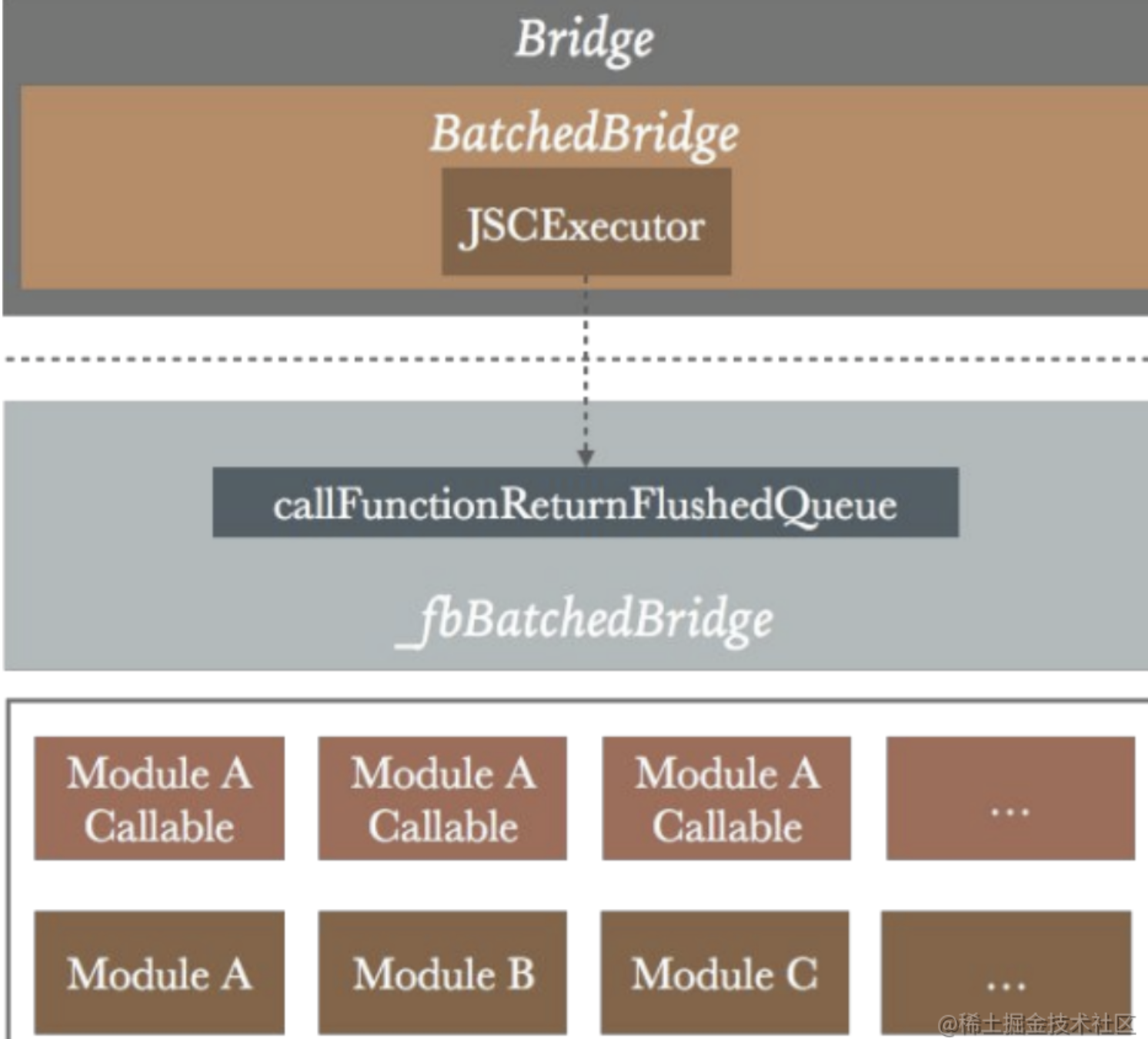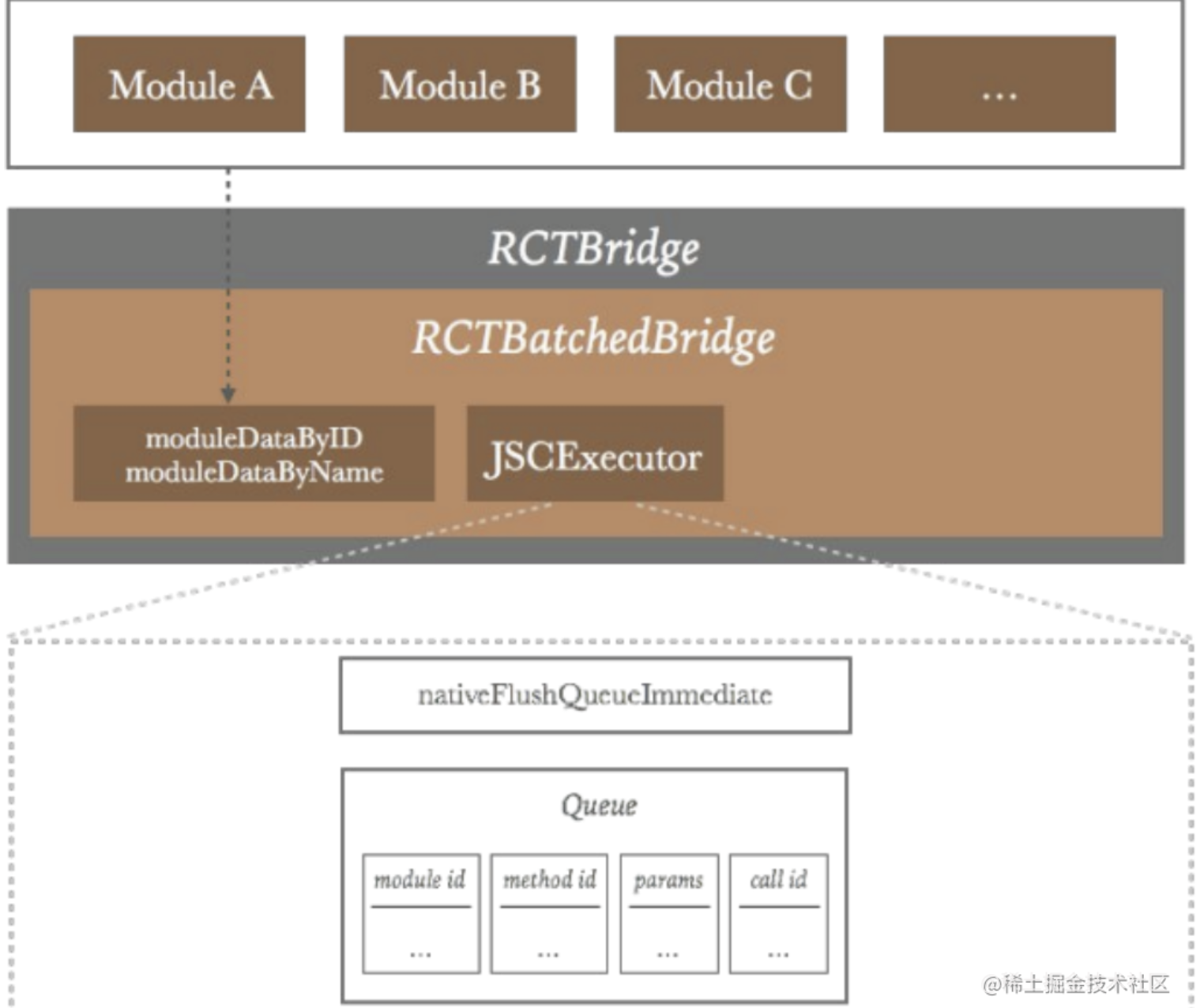
ctx[@"NativeMethod"] = ^(NSString *name) {
// do something
return someResult
}复制
// 创建一个ctx的JS上下文
JSContent *ctx = [[JSContent alloc] init];
// 创建一个变量name
[ctx evaluateScript:@"var name = 'jack'"];
// 创建一个方法
[ctx evaluateScript:@"var sayHi = function(name) { return 'hello ' + name }"];
// 通过ctx上下文对象,获取到hello方法
JSValue *sayHiUnction = ctx[@"sayHi"];
// 运行js方法
JSValue *greetings = [sayHiUnction callWithArguments:@[@"jack"]; // hello jack复制
ReactNative核心知识
// RCTRootView.m
- (void)javaScriptDidLoad:(NSNotification *)notification
{
RCTAssertMainQueue();
RCTBridge *bridge = notification.userInfo[@"bridge"];
if (bridge != _contentView.bridge) {
[self bundleFinishedLoading:bridge];
}
}
- (void)bundleFinishedLoading:(RCTBridge *)bridge
{
// 省略创建RCTRootContentView...
[self runApplication:bridge];
// 省略添加一个RCTRootContentView...
}
- (void)runApplication:(RCTBridge *)bridge
{
NSString *moduleName = _moduleName ?: @""; // 这里是@"NewProject"
NSDictionary *appParameters = @{
@"rootTag": _contentView.reactTag,
@"initialProps": _appProperties ?: @{},
};
[bridge enqueueJSCall:@"AppRegistry" method:@"runApplication" args:@[moduleName, appParameters]
completion:NULL];
}复制

void JSIExecutor::bindBridge() {
std::call_once(bindFlag_, [this] {
SystraceSection s("JSIExecutor::bindBridge (once)");
Value batchedBridgeValue =
runtime_->global().getProperty(*runtime_, "__fbBatchedBridge");
if (batchedBridgeValue.isUndefined() || !batchedBridgeValue.isObject()) {
throw JSINativeException(
"Could not get BatchedBridge, make sure your bundle is packaged correctly");
}
Object batchedBridge = batchedBridgeValue.asObject(*runtime_);
callFunctionReturnFlushedQueue_ = batchedBridge.getPropertyAsFunction(
*runtime_, "callFunctionReturnFlushedQueue");
invokeCallbackAndReturnFlushedQueue_ = batchedBridge.getPropertyAsFunction(
*runtime_, "invokeCallbackAndReturnFlushedQueue");
flushedQueue_ =
batchedBridge.getPropertyAsFunction(*runtime_, "flushedQueue");
});
}复制

void JSIExecutor::initializeRuntime() {
SystraceSection s("JSIExecutor::initializeRuntime");
runtime_->global().setProperty(
*runtime_,
"nativeModuleProxy",
Object::createFromHostObject(
*runtime_, std::make_shared<NativeModuleProxy>(nativeModules_)));
runtime_->global().setProperty(
*runtime_,
"nativeFlushQueueImmediate",
Function::createFromHostFunction(
*runtime_,
PropNameID::forAscii(*runtime_, "nativeFlushQueueImmediate"),
1,
[this](
jsi::Runtime &,
const jsi::Value &,
const jsi::Value *args,
size_t count) {
if (count != 1) {
throw std::invalid_argument(
"nativeFlushQueueImmediate arg count must be 1");
}
callNativeModules(args[0], false);
return Value::undefined();
}));
runtime_->global().setProperty(
*runtime_,
"nativeCallSyncHook",
Function::createFromHostFunction(
*runtime_,
PropNameID::forAscii(*runtime_, "nativeCallSyncHook"),
1,
[this](
jsi::Runtime &,
const jsi::Value &,
const jsi::Value *args,
size_t count) { return nativeCallSyncHook(args, count); }));
runtime_->global().setProperty(
*runtime_,
"globalEvalWithSourceUrl",
Function::createFromHostFunction(
*runtime_,
PropNameID::forAscii(*runtime_, "globalEvalWithSourceUrl"),
1,
[this](
jsi::Runtime &,
const jsi::Value &,
const jsi::Value *args,
size_t count) { return globalEvalWithSourceUrl(args, count); }));
if (runtimeInstaller_) {
runtimeInstaller_(*runtime_);
}
bool hasLogger(ReactMarker::logTaggedMarker);
if (hasLogger) {
ReactMarker::logMarker(ReactMarker::CREATE_REACT_CONTEXT_STOP);
}
}复制
var ele = {
...
type: type, // 元素的类型
key: key, // 元素key标示
ref: ref, // 元素的引用
props: props, // 元素的参数,包含children
...
}
// example 1
<div>hello</div>
// 会被描述为
{type: 'div',
props: {
children: ['hello']
}
}
// example 2
<CustomerComponents />
// 会被描述为
{
type: CustomerComponents
}复制
其他
- (BOOL)application:(UIApplication *)application didFinishLaunchingWithOptions:(NSDictionary *)launchOptions
{
if (!self.bridge) {
self.bridge = [self createBridgeWithDelegate:self launchOptions:launchOptions];
}
NSDictionary *initProps = [self prepareInitialProps];
UIView *rootView = [self createRootViewWithBridge:self.bridge moduleName:self.moduleName initProps:initProps];
if (@available(iOS 13.0, *)) {
rootView.backgroundColor = [UIColor systemBackgroundColor];
} else {
rootView.backgroundColor = [UIColor whiteColor];
}
self.window = [[UIWindow alloc] initWithFrame:[UIScreen mainScreen].bounds];
UIViewController *rootViewController = [self createRootViewController];
rootViewController.view = rootView;
self.window.rootViewController = rootViewController;
[self.window makeKeyAndVisible];
return YES;
}复制
- (void)setUp
{
RCT_PROFILE_BEGIN_EVENT(0, @"-[RCTBridge setUp]", nil);
//_performanceLogger日志工具初始化
//_bundleURL获取
//batchedBridge创建
self.batchedBridge = [[bridgeClass alloc] initWithParentBridge:self];
[self.batchedBridge start];
RCT_PROFILE_END_EVENT(RCTProfileTagAlways, @"");
}
batchedBridge是RCTCXXBridge,它的初始化方法如下:
- (instancetype)initWithParentBridge:(RCTBridge *)bridge
{
RCTAssertParam(bridge);
if ((self = [super initWithDelegate:bridge.delegate
bundleURL:bridge.bundleURL
moduleProvider:bridge.moduleProvider
launchOptions:bridge.launchOptions])) {
_parentBridge = bridge;
_performanceLogger = [bridge performanceLogger];
registerPerformanceLoggerHooks(_performanceLogger);
/**
* Set Initial State
*/
_valid = YES;
_loading = YES;
_moduleRegistryCreated = NO;
_pendingCalls = [NSMutableArray new];
_displayLink = [RCTDisplayLink new];
_moduleDataByName = [NSMutableDictionary new];
_moduleClassesByID = [NSMutableArray new];
_moduleDataByID = [NSMutableArray new];
_objCModuleRegistry = [RCTModuleRegistry new];
[_objCModuleRegistry setBridge:self];
_bundleManager = [RCTBundleManager new];
[_bundleManager setBridge:self];
_viewRegistry_DEPRECATED = [RCTViewRegistry new];
[_viewRegistry_DEPRECATED setBridge:self];
_callableJSModules = [RCTCallableJSModules new];
[_callableJSModules setBridge:self];
[RCTBridge setCurrentBridge:self];
[[NSNotificationCenter defaultCenter] addObserver:self
selector:@selector(handleMemoryWarning)
name:UIApplicationDidReceiveMemoryWarningNotification
object:nil];
RCTLogSetBridgeModuleRegistry(_objCModuleRegistry);
RCTLogSetBridgeCallableJSModules(_callableJSModules);
}
return self;
}
- (void)start
{
RCT_PROFILE_BEGIN_EVENT(RCTProfileTagAlways, @"-[RCTCxxBridge start]", nil);
[[NSNotificationCenter defaultCenter] postNotificationName:RCTJavaScriptWillStartLoadingNotification
object:_parentBridge
userInfo:@{@"bridge" : self}];
//启动JS线程
_jsThread = [[NSThread alloc] initWithTarget:[self class] selector:@selector(runRunLoop) object:nil];
_jsThread.name = RCTJSThreadName;
_jsThread.qualityOfService = NSOperationQualityOfServiceUserInteractive;
#if RCT_DEBUG
_jsThread.stackSize *= 2;
#endif
[_jsThread start];
dispatch_group_t prepareBridge = dispatch_group_create();
[_performanceLogger markStartForTag:RCTPLNativeModuleInit];
//1.初始化Native Modules
[self registerExtraModules];
//2.创建Native Modules配置表
// Initialize all native modules that cannot be loaded lazily
(void)[self _initializeModules:RCTGetModuleClasses() withDispatchGroup:prepareBridge lazilyDiscovered:NO];
[self registerExtraLazyModules];
[_performanceLogger markStopForTag:RCTPLNativeModuleInit];
// This doesnt really do anything. The real work happens in initializeBridge.
_reactInstance.reset(new Instance);
__weak RCTCxxBridge *weakSelf = self;
// 3.准备JS引擎工厂,创建JS引擎
std::shared_ptr<JSExecutorFactory> executorFactory;
if (!self.executorClass) {
if ([self.delegate conformsToProtocol:@protocol(RCTCxxBridgeDelegate)]) {
id<RCTCxxBridgeDelegate> cxxDelegate = (id<RCTCxxBridgeDelegate>)self.delegate;
executorFactory = [cxxDelegate jsExecutorFactoryForBridge:self];
}
// 4.将Modules配置信息注册到JS引擎中
if (!executorFactory) {
auto installBindings = RCTJSIExecutorRuntimeInstaller(nullptr);
#if RCT_USE_HERMES
executorFactory = std::make_shared<HermesExecutorFactory>(installBindings);
#else
executorFactory = std::make_shared<JSCExecutorFactory>(installBindings);
#endif
}
} else {
id<RCTJavaScriptExecutor> objcExecutor = [self moduleForClass:self.executorClass];
executorFactory.reset(new RCTObjcExecutorFactory(objcExecutor, ^(NSError *error) {
if (error) {
[weakSelf handleError:error];
}
}));
}
//_turboModuleRegistry是一个TurboModule注册表,TurboModule是JS在RN中的一种优化方式,将常用的JS代码编译成可执行代码,提高执行速度。
/**
* id<RCTCxxBridgeDelegate> jsExecutorFactory may create and assign an id<RCTTurboModuleRegistry> object to
* RCTCxxBridge If id<RCTTurboModuleRegistry> is assigned by this time, eagerly initialize all TurboModules
*/
if (_turboModuleRegistry && RCTTurboModuleEagerInitEnabled()) {
for (NSString *moduleName in [_turboModuleRegistry eagerInitModuleNames]) {
[_turboModuleRegistry moduleForName:[moduleName UTF8String]];
}
for (NSString *moduleName in [_turboModuleRegistry eagerInitMainQueueModuleNames]) {
if (RCTIsMainQueue()) {
[_turboModuleRegistry moduleForName:[moduleName UTF8String]];
} else {
id<RCTTurboModuleRegistry> turboModuleRegistry = _turboModuleRegistry;
dispatch_group_async(prepareBridge, dispatch_get_main_queue(), ^{
[turboModuleRegistry moduleForName:[moduleName UTF8String]];
});
}
}
}
// Dispatch the instance initialization as soon as the initial module metadata has
// been collected (see initModules)
dispatch_group_enter(prepareBridge);
[self ensureOnJavaScriptThread:^{
[weakSelf _initializeBridge:executorFactory];
dispatch_group_leave(prepareBridge);
}];
// 5.加载boundle代码
// Load the source asynchronously, then store it for later execution.
dispatch_group_enter(prepareBridge);
__block NSData *sourceCode;
[self
loadSource:^(NSError *error, RCTSource *source) {
if (error) {
[weakSelf handleError:error];
}
sourceCode = source.data;
dispatch_group_leave(prepareBridge);
}
onProgress:^(RCTLoadingProgress *progressData) { }];
// 模块和js代码加载完成后,执行js代码
// Wait for both the modules and source code to have finished loading
dispatch_group_notify(prepareBridge, dispatch_get_global_queue(QOS_CLASS_USER_INTERACTIVE, 0), ^{
RCTCxxBridge *strongSelf = weakSelf;
if (sourceCode && strongSelf.loading) {
// 6.执行boundle代码
[strongSelf executeSourceCode:sourceCode sync:NO];
}
});
RCT_PROFILE_END_EVENT(RCTProfileTagAlways, @"");
}复制
// js thread only (which surprisingly can be the main thread, depends on used JS executor)
- (void)flushEventsQueue
{
[_eventQueueLock lock];
NSDictionary *events = _events;
_events = [NSMutableDictionary new];
NSMutableArray *eventQueue = _eventQueue;
_eventQueue = [NSMutableArray new];
_eventsDispatchScheduled = NO;
[_eventQueueLock unlock];
for (NSNumber *eventId in eventQueue) {
[self dispatchEvent:events[eventId]];
}
}复制
- (instancetype)initWithFrame:(CGRect)frame
bridge:(RCTBridge *)bridge
reactTag:(NSNumber *)reactTag
sizeFlexiblity:(RCTRootViewSizeFlexibility)sizeFlexibility
{
if ((self = [super initWithFrame:frame])) {
_bridge = bridge;
self.reactTag = reactTag;
_sizeFlexibility = sizeFlexibility;
_touchHandler = [[RCTTouchHandler alloc] initWithBridge:_bridge];
[_touchHandler attachToView:self];
[_bridge.uiManager registerRootView:self];
}
return self;
}复制
RCT_EXPORT_METHOD(createView
: (nonnull NSNumber *)reactTag viewName
: (NSString *)viewName rootTag
: (nonnull NSNumber *)rootTag props
: (NSDictionary *)props)
{
RCTComponentData *componentData = _componentDataByName[viewName];
if (componentData == nil) {
RCTLogError(@"No component found for view with name \"%@\"", viewName);
}
// Register shadow view
RCTShadowView *shadowView = [componentData createShadowViewWithTag:reactTag];
if (shadowView) {
[componentData setProps:props forShadowView:shadowView];
_shadowViewRegistry[reactTag] = shadowView;
RCTShadowView *rootView = _shadowViewRegistry[rootTag];
RCTAssert(
[rootView isKindOfClass:[RCTRootShadowView class]] || [rootView isKindOfClass:[RCTSurfaceRootShadowView class]],
@"Given `rootTag` (%@) does not correspond to a valid root shadow view instance.",
rootTag);
shadowView.rootView = (RCTRootShadowView *)rootView;
}
// Dispatch view creation directly to the main thread instead of adding to
// UIBlocks array. This way, it doesnt get deferred until after layout.
__block UIView *preliminaryCreatedView = nil;
void (^createViewBlock)(void) = ^{
// Do nothing on the second run.
if (preliminaryCreatedView) {
return;
}
preliminaryCreatedView = [componentData createViewWithTag:reactTag rootTag:rootTag];
if (preliminaryCreatedView) {
self->_viewRegistry[reactTag] = preliminaryCreatedView;
}
};
// We cannot guarantee that asynchronously scheduled block will be executed
// *before* a block is added to the regular mounting process (simply because
// mounting process can be managed externally while the main queue is
// locked).
// So, we positively dispatch it asynchronously and double check inside
// the regular mounting block.
RCTExecuteOnMainQueue(createViewBlock);
[self addUIBlock:^(__unused RCTUIManager *uiManager, __unused NSDictionary<NSNumber *, UIView *> *viewRegistry) {
createViewBlock();
if (preliminaryCreatedView) {
[componentData setProps:props forView:preliminaryCreatedView];
}
}];
[self _shadowView:shadowView didReceiveUpdatedProps:[props allKeys]];
}
复制